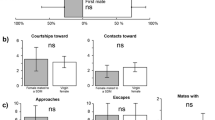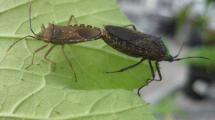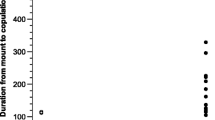Abstract
It is generally assumed that mating history has potentially important effects on the mating biology of insects, and differences in mating success of males, in relation to their mating history, have been commonly documented in Lepidoptera. Mating success of male European corn borer Ostrinia nubilalis, in relation to their mating history, and consequent fitness parameters for their female mates, were investigated. Mating experience significantly increased mating success for O. nubilalis males. Mating with experienced males significantly reduced lifetime fecundity and longevity of females. Sperm depletion, transfer of less nutritive substances or more toxic substances may explain the female response to mating with experienced males. Male persistence or some other compensatory mechanism may account for female acceptance of experienced males.



Similar content being viewed by others
References
Andersson M (1994) Sexual Selection. Princeton University Press, Princeton
Andow DA, Stodola TJ (2003) European corn borer rearing manual. http://www.entomology.umn.edu/ecb_manual/
Arnqvist G (1997) The evolution of water strider mating systems: causes and consequences of sexual conflicts. In: Choe JC, Crespi BJ (eds) The evolution of mating systems in insects and arachnids. Cambridge University Press, Cambridge, pp 146–163
Arnqvist G, Nilsson T (2000) The evolution of polyandry: multiple mating and female fitness in insects. Anim Behav 60:145–164
Burington RS (1965) Handbook of mathematical tables and formulas. McGraw-Hill, Toronto
Chapman T, Arnqvist G, Bangham J, Rowe L (2003) Sexual conflict. Trends Ecol Evol 18:41–47. doi:10.1016/S0169-5347(02)00004-6
Cook DF (1995) Influence of previous mating experience on future mating success in male Lucilia cuprina (Diptera: Calliphoridae). J Insect Behav 8:207–217
Cox DR, Oakes D (1984) Analysis of Survival Data. Chapman and Hall, London
Dewsbury DA (1982) Ejaculate cost and male choice. Am Nat 119:601–610
Dukas R (2005) Experience improves courtship in male fruit flies. Anim Behav 69:1203–1209
Edvardsson M, Hunt J, Moore PJ, Moore AJ (2008) Female agreement over male attractiveness is not affected by cost of mating with experienced males. Behav Ecol 19:854–859
Foster SP, Ayers RH (1996) Multiple mating and its effects in the lightbrown apple moth, Epiphyas postvittana (Walker). J Insect Physiol 42:657–667
Fricke C, Maklakov AA (2007) Male age does not affect female fitness in a polyandrous beetle, Callosobruchus maculatus. Anim Behav 74:541–555
Gelman DB, Hayes DK (1982) Methods and markers for synchronizing maturation of fifth-stage larvae and pupae of the European corn borer, Ostrinia nubilalis (Lepidoptera: Pyralidae). Ann Entomol Soc Am 75:485–493
Glover TJ, Tang XH, Roelofs WL (1987) Sex pheromone blend discrimination by male moths from E and Z strains of European corn borer. J Chem Ecol 13:143–151
Head M, Hunt J, Jennions MD, Brooks R (2005) The indirect benefits of mating with attractive males outweigh the direct costs. PLoS Biol 3:e33
Hinton JL, Andow DA (2003) Mating frequency of European corn borer (Lepidoptera: Crambidae) in Minnesota, Kansas, and Texas. Great Lakes Entomol 36:156–159
Holland B, Rice WR (1998) Chase-away sexual selection: antagonistic seduction versus resistance. Evolution 52:1–7
Hou ML, Sheng CF (1999) Fecundity and longevity of Helicoverpa armigera (Lepidoptera: Noctuidae): effects of multiple mating. J Econ Entomol 92:569–573
Hu Y, Andow DA (2009) A technique for distinguishing virgin and mated males of Ostrinia nubilalis (hübner) (lepidoptera: Crambidae). J Entomol Sci 44:264–275
Ivengar VK (2009) Experience counts: females favor multiply mated males over chemically endowed virgins in a moth (Utetheisa ornatrix). Behav Ecol Sociobiol 63:847–855
Iwasa Y, Pomiankowski A, Nee S (1991) The evolution of costly mate preferences. II. The ‘handicap’ principle. Evolution 45:1431–1442
Iwasa Y, Pomiankowski A (1999) Good parent and good genes models of handicap evolution. J Theor Biol 200:97–109
Jervis MA, Boggs LC, Ferns NP (2007) Egg maturation strategy and survival trade-offs in holometabolous insects: a comparative approach. Biol J Linn Soc 90:293–302
Jiménez-Pérez A, Wang Q (2004) Sexual selection in Cnephasia jactatana (Lepidoptera: Tortricidae) in relation to age, virginity, and body size. Ann Entomol Soc Am 97:819–824
Jones TM, Elgar MA (2004) The role of male age, sperm age and mating history on fecundity and fertilization success in the hide beetle. Proc Biol Sci 271:1311–1318
Jones TM, Balmford A, Quinnell RJ (2000) Adaptive female choice for middle-aged mates in a lekking sandfly. Proc Biol Sci 267:681–686
Kaitala A, Wiklund C (1995) Female mate choice and mating costs in the polyandrous butterfly Pieris napi (Lepidoptera: Pieridae). J Insect Behav 8:355–363
King BH, Fischer CR (2009) Male mating history: effects on female sexual responsiveness and reproductive success in the parasitoid wasp Spalangia endius. Behav Ecol Sociobiol 64:607–615. doi:10.1007/s00265-009-0878-3
Kirkpatrick M (1982) Sexual selection and the evolution of female choice. Evolution 36:1–12
Kirkpatrick M, Barton NH (1997) The strength of indirect selection on female mating preferences. Proc Natl Acad Sci USA 94:1282–1286
Klepetka B, Gould F (1996) Effects of age and size on mating in Heliothis virescens (Lepidoptera: Noctuidae): implications for resistance management. Environ Entomol 25:993–1001
Krupke CH, Brunner JF, Jones VP (2008) Factors influencing mate choice in Euschistus conspersus Uhler (Heteroptera: Pentatomidae). Environ Entomol 37:192–197
Lassance JM, Löfstedt C (2009) Concerted evolution of male and female display traits in the European corn borer, Ostrinia nubilalis. BMC Biology 7:10. doi:10.1186/1741-7007-7-10
Lauwers K, Van Dyck H (2006) The cost of mating with a non-virgin male in a monandrous butterfly: experimental evidence from the speckled wood, Pararge aegeria. Behav Ecol Sociobiol 60:69–76
Leahy TC, Andow DA (1994) Egg weight, fecundity, and lon-evity are increased by adult feeding in Ostrinia nubilalis (Lepidoptera: Pyralidae). Ann Entomol Soc Am 87:342–349
Markow TA, Quaid M, Kerr S (1978) Male mating experience and competitive courtship success in Drosophila melanogaster. Nature 276:821–822
Mason CE, Rice ME, Calvin DD et al. (1996) European corn borer ecology and management. North Central Region Extension Publication 327. Ames, Iowa: Iowa State University
McNamara K, Jones TM, Elgar MA (2007) No cost of male mating experience on female reproductive success in the almond moth, Cadra cautella (Lepidoptera: Pyralidae). Behav Ecol Sociobiol 61:1177–1184
Milonas PG, Andow DA (2010) Virgin male age and mating success in Ostrinia nubilalis (Lepidoptera: Crambidae). Anim Behav 79:509–514
Parker GA (2006) Sexual conflict over mating and fertilization: an overview. Philos Trans R Soc Lond B Biol Sci 28(361):235–259. doi:10.1098/rstb.2005.1785
Perez-Staples D, Martinez-Hernandez MG, Aluja M (2010) Male age and experience increases mating success but not female fitness in the Mexican fruit fly. Ethology 116:778–786
Pomiankowski A, Iwasa Y, Nee S (1991) Evolution of costly mate preferences. I. Fisher and biased mutation. Evolution 45:1422–1430
Price T, Schluter D, Heckman NE (1993) Sexual selection when the female directly benefits. Biol J Linn Soc 48:187–211
Rice WR (2000) Dangerous Liaisons. Proc Natl Acad Sci USA 97:12953–12955
Rice WR, Holland B (1997) The enemies within: intergenomic conflict, interlocus contest evolution (ICE), and the intraspecific Red Queen. Behav Ecol Sociobiol 41:1–10
Rönn J, Katvala M, Arnqvist G (2007) Coevolution between harmful male genitalia and female resistance in seed beetles. Proc Natl Acad Sci USA 104(26):10921–10925
Royer L, McNeil JN (1992) Male investment in the European corn borer, Ostrinia nubilalis (Lepidoptera: Pyralidae): impact on female longevity and reproductive performance. Funct Ecol 7:209–215
Rutowski RL, Gilchrist GW, Terkanian B (1987) Female butterflies mated with recently mated males show reduced reproductive output. Behav Ecol Sociobiol 20:319–322
Schlaepfer MA, McNeil JN (2000) Are virgin male lepidopterans more successful in mate acquisition than previously mated individuals? A study of the European corn borer, Ostrinia nubilalis (Lepidoptera: Pyralidae). Can J Zool 78:2045–2050
Schwartz JM (1991) Effect of sexual experience on male mating success in Drosophila silvestris. Anim Behav 42:1017–1019
Scott D, Richmond RC, Carlson DA (1988) Pheromones exchanged during mating: a mechanism for mate assessment in Drosophila. Anim Behav 36:1164–1173
Simmons LW, Teale RJ, Maier M, Standish RJ, Bailey WJ, Withers PC (1992) Some costs of reproduction for male bushcrickets, Requena verticalis (Orthoptera: Tettigoniidae): allocating resources to mate attraction and nuptial feeding. Behav Ecol Sociobiol 31:57–62
Sokal RR, Rohlf FJ (1995) Biometry, 3rd edn. Freeman, New York
Thornhill R, Alcock J (1983) The evolution of insect mating systems. Harvard University Press, Cambridge
Torres-Vila LM, Jennions MD (2005) Male mating history and female fecundity in the Lepidoptera: do male virgins make better partners? Behav Ecol Sociobiol 57:318–326
Trivers RL (1972) Parental investment and sexual selection. In: Campbell B (ed) Sexual selection and the descent of man, 1871-1971. Heinemann, London, pp 136–179
Vahed K (1998) The function of nuptial feeding in insects: a review of empirical studies. Biol Rev 73:43–78
Vahed K (2006) Larger ejaculate volumes are associated with a lower degree of polyandry across bushcricket taxa. Proc Biol Sci 273:2387–2394
Wade MJ, Pruett-Jones S (1990) Female copying increases the variance in male mating success. Proc Natl Acad Sci 87:5749–5753
Webster RP, Cardé RT (1984) Role of (Z)- and (E)-11-tetradecenyl acetate pheromone components in the sexual behaviour of the (Z) strain of the Europena corn borer, Ostrinia nubilalis (Lepidoptera: Pyralidae). J Chem Ecol 10:9–15
Wedell N (1993) Spermatophore size in bushcrickets: comparative evidence for nuptial gifts as sperm protection devices. Evolution 47:1203–1212
Wedell N (1997) Ejaculate size in bushcrickets: The importance of being large. J Evol Biol 10:315–325
Wedell N, Ritchie MG (2004) Male age, mating status and nuptial gift quality in a bushcricket. Anim Behav 67:1059–1065
Wedell N, Gage MJG, Parker GA (2002) Sperm competition, male prudence, and sperm-limited females. Trends Ecol Evol 17:313–320
Wedell N, Wiklund C, Bergström J (2009) Coevolution of non-fertile sperm and female receptivity in a butterfly. Biol Lett 5:678–681
Acknowledgements
We thank two anonymous reviewers for their helpful comments that improved the manuscript. This work was supported by a fellowship from Organisation for Economic Co-Operation and Development Co-operative Research Programme to PGM and USDA Regional Research Project NC-205.
Author information
Authors and Affiliations
Corresponding author
Additional information
Communicated by M. Siva-Jothy
Rights and permissions
About this article
Cite this article
Milonas, P.G., Farrell, S.L. & Andow, D.A. Experienced males have higher mating success than virgin males despite fitness costs to females. Behav Ecol Sociobiol 65, 1249–1256 (2011). https://doi.org/10.1007/s00265-011-1138-x
Received:
Revised:
Accepted:
Published:
Issue Date:
DOI: https://doi.org/10.1007/s00265-011-1138-x




